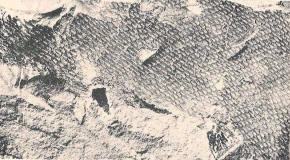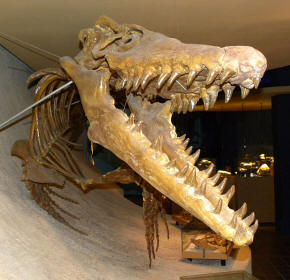|
Description
Mosasaurs breathed air, were
powerful swimmers, and were well-adapted to living in the warm, shallow
epicontinental seas
prevalent during the Late Cretaceous Period. Mosasaurs were so well adapted
to this environment that they
gave
birth to live young, rather than return to
the shore to lay eggs, as
sea
turtles do.
The smallest-known mosasaur was
Carinodens belgicus,
which was about 3.0 metres (9.8 ft) to 3.5 metres (11 ft) long and probably
lived in shallow waters near shore, cracking
mollusks and
sea
urchins with its bulbous teeth. Larger
mosasaurs were more typical: mosasaurs ranged in size up to 17 metres (56
ft).
Tylosaurus holds the
record for longest mosasaur, at 17.5 metres (57 ft).
Mosasaurs had a body shape similar
to that of modern-day monitor lizards (varanids), but were more elongated
and streamlined for swimming. Their limb bones were reduced in length and
their paddles were formed by webbing between their elongated digit-bones.
Their tails were broad, and supplied the locomotive power. This method of
locomotion may have been similar to that used by the
conger eel or
sea
snakes today. However, more recent evidence
suggests that many advanced mosasaurs had large crescent-shaped flukes on
the ends of their tails similar to those of sharks
and ichthyosaurs. Rather
than snake-like undulatory movement, the body probably remained stiff in
these mosasaurs to improve hydrodynamic efficiency through the water while
the end of the tail provided strong propulsion.
The animal may have lurked and pounced rapidly and powerfully on passing
prey, rather than hunting for it.
Mosasaurs had a double-hinged jaw
and flexible skull (much like that of a snake),
which enabled them to gulp down their prey almost whole, a snakelike habit
which helped identify the unmasticated gut contents fossilized within
mosasaur skeletons. A skeleton of
Tylosaurus proriger from
South Dakota included remains of the diving
seabird
Hesperornis, a marine
bony fish, a possible
shark and another, smaller mosasaur
(Clidastes). Mosasaur bones have also been found with shark teeth embedded
in them.
Based on features
such as the double row of pterygoid ("flanged") teeth on the palate, the
double-hinged jaw, modified/reduced limbs and probable methods of
locomotion, many researchers believe that snakes
and mosasaurs may have had a common ancestor. This theory was first
suggested in 1869, by
Edward Drinker Cope,
who coined the term "Pythonomorpha" to include them. The idea lay dormant
for more than a century, before being revived in the 1990s.
Soft tissue
Despite the relatively high number
of mosasaur remains collected worldwide, knowledge of the nature of their
skin coverings remains in its early stages. An incredibly small amount of
mosasaurid specimens collected from around the world retain fossilized scale
imprints; this
 |
| Scales of Tylosaurus proriger (KUVP-1075) |
lack of knowledge is possibly due to the delicate nature of
the scales, which nearly eliminates possibility of preservation, in addition
to the preservation sediments types and the marine conditions under which
the preservation occurred. Until the discovery of several mosasaur specimens
along with their remarkably well preserved scale imprints from late
Maastrichtian deposits of the
Muwaqqar Chalk Marl Formation
of Harrana in Jordan,
knowledge of the nature of mosasaur integument was mainly based on very few
accounts describing early mosasaur fossils dating back to the upper
Santonian-lower
Campanian such as the famous
Tylosaurus specimen (KUVP-1075) from Cove County, Kansas.
Material from Jordan has shown that the body of mosasaurs, as well as the
membrane between the fingers and toes, was covered with small overlapping
diamond-shaped scales resembling those of snakes. Much like modern reptiles,
there existed regional variations in the type and size of the scales that
covered the mosasaurs. In Harrana specimens, two types of scales were
observed on a single specimen, keeled scales
covering the upper regions of the body as well as smooth scales covering the
lower regions. As ambush predators, lurking and quickly capturing prey using
stealth tactics, it is suggested mosasaurs
benefited greatly from the non-reflective keeled scales.
More recently, a well preserved
fossil of
Platecarpus tympaniticus
has been found that preserves not only skin impressions, but also internal
organs. There are several reddish areas in the fossil that may represent the
heart, lungs, and kidneys. The trachea is also preserved along with part of
what may be the
retina in the eye. The
placement of the kidneys is farther forward in the abdomen than it is in
monitor lizards, and is more similar to that of
cetaceans. As in cetaceans, the
bronchi
leading to the lungs run parallel to each other instead of splitting apart
from one another as in monitors and other terrestrial reptiles. In
mosasaurs, these features may be internal adaptations to a fully marine
lifestyle.
In 2011,
collagen protein was recovered from a
Prognathodon humerus dated to the
Cretaceous.
Environment
Sea levels were high during the
Cretaceous Period, causing marine transgressions in many parts of the world
and a
great inland seaway in
what is now North America. Mosasaur fossils
have been found in the
Netherlands, Belgium,
Denmark,
Portugal, Sweden,
the United Kingdom,
Angola,
Morocco,
Australia, New
Zealand, and on Vega
Island off the coast of Antarctica.
Mosasaurs have been found in Canada
in Manitoba and
Saskatchewan and in much of the contiguous
United States. Complete or partial specimens have been found in Alabama,
Mississippi,
Tennessee, and Georgia -- as well as
in states covered by the Cretaceous seaway: Texas,
southwest Arkansas, New Mexico, Kansas, Colorado, Nebrask, South Dakota,
Montana, and the
Pierre Shale/Fox
Hills formations of North Dakota.
Lastly, mosasaur bones and teeth are also known from
California, Mexico,
and
Peru.
Many of the so-called 'dinosaur'
remains found on New Zealand are
actually mosasaurs and
plesiosaurs, both being Mesozoic predatory
marine reptiles.
Evolutionary antecedents
Based on features such as the
loosely-hinged jaw, modified/reduced limbs and probable locomotion, many
researchers believe that snakes share a common marine ancestry with
mosasaurs, a suggestion advanced in 1869, by
Edward Drinker Cope,
who coined the term "Pythonomorpha" to unite them. The idea lay dormant for
more than a century, to be revived in the 1990s.
Recently, the discovery of
Najash rionegrina, a
fossorial snake from South America cast doubt on the marine origin theory.
In 2005, research reported in
Netherlands Journal of Geosciences, confirmed that the recently uncovered
Dallasaurus turneri is
an early link between land-based
monitor lizards (such as the
Komodo dragon) and the aquatic mosasaurs.
In popular culture
Mosasaurs appear in the BBC
television series
Sea Monsters. Mosasaurs
also feature heavily in the ITV television series
Primeval. In this show,
the mosasaurs are depicted incorrectly as having skin more like a
crocodile's. A highly evolved mosasaur appeared in an episode of
Godzilla: The Series.
It was inhabiting
Loch Ness as the
legendary
Loch Ness Monster.
The IMAX 3D film "Sea Monsters"
features several mosasaurs (including Tylosaurus and
Platecarpus) with detailed animated
recreations of their movements and activities.
In Disney's
Fantasia, there is a scene where a pod of
mosasaurs are swimming by and one of them grabs a pteranodon.
Return to the
Old Earth Ministries Online Dinosaur
Curriculum homepage.

Shopping
Bay
State Replicas - T-rex teeth, claws, skulls, jaws, foot, rib, femur,
complete skeleton (1/20 scale), brain cavity
Black
Hills Institute - Full size skulls, skeletons, 1/6th scale
disartictulated skull, teeth, arm, leg, femur, foot, claws.
Wall-mounted half-skull.
|



